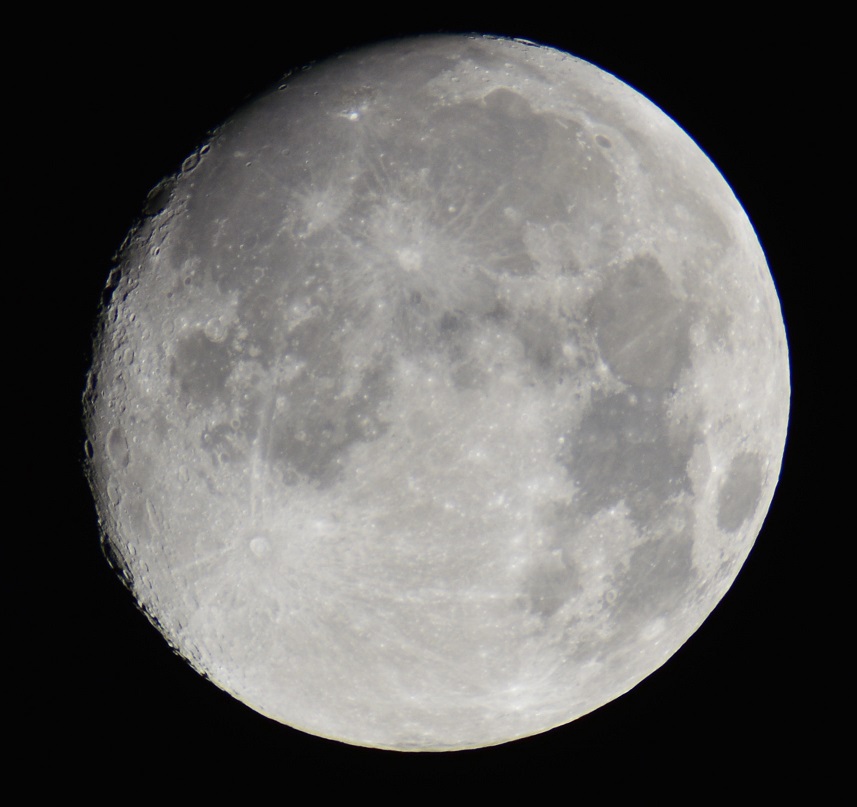![]()
The materials of the Moon
(English version of the post «Los materiales de la Luna«)
The view of the Moon delights us in unclouded nights. We can see its non-homogeneous surface: the different reflexion properties of the brighter and darker regions have made us to imagine on it a face or other images. Besides, we are surprised by these differences and we wonder what the materiales that reflect the Sun light so differently are.
The first astronomers could imagine that the dark regions were seas of water. Moreover, it was easy to guess that the impressive craters had been produced by the impacts of large objects. Those craters and the cracks on the Moon surface, and also the dark seas, make the extremely beautiful visage. It can be observed in great detail by using, for instance, a photography camera equipped with a teleobjective (see figure 1). Along the history, the astronomers have identified and named the myriad of craters and the seas.

The seas of the Moon don’t contain water and their darker color is due to their composition. The rocks originated from volcanoes that existed in the Moon a long time ago remain in the seas. By progressive cooling, the lunar volcanoes have lost their activity. Eruptions took place sometimes after the impacts of asteroids or meteoroids. The rocks of volcanic origin, which are basaltic, are darker than the rocks on the lunar crust which form the bright regions. On the lunar seas landed the first vehicle that succesfully got a soft landing (Luna 9, de la URSS, en 1966) and the first humans of the Apollo 11 mission (landing at Sea of Tranquility, 1969). The Apolo 11 mission brought more than 20 kg of lunar samples back to Earth. Those samples and the samples from subsequent expeditions have allowed us to establish the composition of the lunar dust and surface rocks: essentially silicon, aluminum, calcium, iron, magnesium titanium an sodium oxides. Distributed by the US government as gifts, lunar samples are kept in many North-American cities and in various countries.
The similar proportion of oxygen and tungsten isotopes in the lunar and terrestrial minerals, the density of the Moon (lower than the average density of the Earth but similar to the terrestrial mantle), and also the possible explanations for the origin of the Earth-Moon system, have convinced the astronomers that the Earth and the Moon were initially a single object. The most accepted theory is that the separation occurred after a great impact, during the first epoque of the Solar System. That impact produced a ring of debris orbiting around the nascent Earth. The calculations of this model predict that the debris would have formed the Moon in a few years and, moreover, that most of the material in the new satellite would be initially molten, as a magma. All the lunar rocks are igneous, formed through the cooling of the magma, slowly or more rapidly at the seas.
The fragments of rocks and dust on the lunar surface are called regolith and derive from the rocks. They are the products of variuos rupture mechanisms, including:
- Fractures produced by the impacts of meteoroids and asteroids. Once the Moon solidified, and since its materials are rocks that are fragile (they absorve low energy during the breaking process), the impacts produce myriads of cracks.
- Tidal forces. The tidal forces would have contributed to mold the Moon during the solidifying process. The dissipation of energy during the deformation of the materials in the volume of the Moon by the tides would slow down the rotation of the Moon to the point of making it rotate with the same period of translation around the Earth, so that the visible face of the Moon is always the same.* Nowadays, the tides on the Moon produce cyclic loading of the rocks, because of the non-circular elliptic orbit of the Moon. Cyclic loading may produce the rupture of materials, by a process known as fatigue. Typically, the fatigue produces a cumulative damage by progressive microcracking. The ruptures of lunar rocks, at a certain depth, may produce seisms.
- Stresses originated by the change of temperature between day and night: there is a superposition of temperature variation and stress variation. Typically it is known as thermal fatigue and the result is, again, the progressive damage and final rupture of the material.
- Solar radiation, which may produce direct damage by breaking chemical bonds.
Impacts of asteroids and meteoroids and volcanoes have drawn the beautiful shapes on the lunar surface, stimulating our imagination. The Moon shows us its old wounds, which have remained unaltered during some billions of years. The Earth had similar wounds and now they are attenuated or cleaned by the displacements and deformation of the tectonic plates, eroded by atmospheric of hydrological agents and by the action of living beings.
—————
* Similarly, tides on the Earth dissipate energy by the friction of materials and the movement of water. Slowly, this dissipation of energy slows down the rotation of the Earth, which would reach a stable rotation period by keeping the same face in front of the Moon, if there were not other changes in the Solar System.
